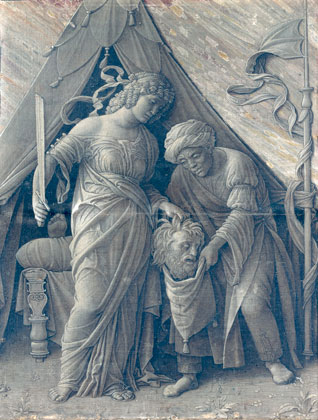The Madonna della Vittoria and the painted reliefs
The Madonna della Vittoria was commissioned by Francesco II Gonzaga to commemorate the doubtful victory over the French troops of Charles VIII at Fornovo, near Parma, July 6, 1495.
A year after the battle, the painting was carried in a solemn procession to the new church of Santa Maria della Vittoria.
Military allusions are not lacking: kneeling and in armor, the marquis expresses his gratitude to the Virgin Mary. Among the personages who surround the marble throne are three warrior saints in sumptuous parade dress; on the left, Saint Michael, with his great sword studded with precious stones, and on the right Saint George with his broken lance, like some “Wagnerian” hero. Behind, the two patron saints of Mantua, Andrew, recognizable by his attribute, the cross, and Longinus, with his plumed helmet. With Saint Elizabeth and the little Saint John, they are all placed under an open-work bower with lemon and orange trees on which birds perch.
On the base of the throne, like in a series of paintings of small dimensions imitating gilt bronze or stone reliefs. Mantegna competes with sculpture in his illusionist effects.
Andrea Mantegna (Isola di Carturo, circa 1431 - Mantua, 1506)
Judith with Her Maidservant Abra
circa 1495
Canvas; H. 48.1 cm; W. 36.7 cm
Dublin, National Gallery of Ireland, inv. 442
© Photograph courtesy of the National Gallery of Ireland







